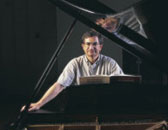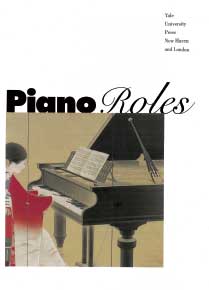Piano Man
In Piano Roles, James Parakilas reveals an instrument whose remarkable resonance isn’t just musical.
By Doug Hubley
Sometimes a cigar is just a cigar, as Sigmund Freud is supposed to have said. But almost never is a piano just a piano.

In its 300-year history, the piano has far transcended pure music, reaching into far-flung and surprising corners of human endeavor. If music is the universal language, in fact, you could call the piano its telephone.
James Parakilas, professor of music, has advanced this notion with success as the lead author of Piano Roles: Three Hundred Years of Life with the Piano, a cultural history of the piano published last spring.
Piano Roles shines as an example of this genre of historical writing, as opposed to a more linear, names-and-dates work. Yes, we do learn how the piano was invented around 1700, by one Bartolomeo Cristofori, whose breakthrough was to allow the musician control over volume from note to note. But we also learn how the piano “has always exhibited a unique power to act as a cultural go-between” connecting different parts of society.
The piano in countless middle-class living rooms often serves less to entertain the family than to entertain hopes: for more education, greater success, higher society. Its music offers the listener a “foretaste, aftertaste, or imaginary taste” of grander, more glamorous worlds – though not necessarily the black-tux kind of glamour, as Jerry Lee Lewis and Liberace remind us. Hollywood has long understood the piano’s symbolic magic. In Casablanca, Sam’s piano is a repository of dreams; in the opening undersea scenes of Titanic, a ruined grand piano represents past and ruined glory.
The book’s overriding message is that no one world has exclusive claim to the piano – not the glittering world of musical heroes nor the mundane private realm where we make our own music. Through the piano, Parakilas says, “those two facets of musical life are completely interrelated.”
Parakilas and 14 contributors (including two Bates colleagues, Atsuko Hirai and Jane Costlow) treat a dazzling array of topics in Piano Roles. “There’s a kind of cultural diversity to the volume that I think Jim intentionally tried to go for,” said Costlow, associate professor of Russian, who translated excerpts from an essay by poet Marina Tsvetaeva. “So I think it’s just rich in a way that would be really hard for one person to do.”
Parakilas wrote about half of the text, but his greater role was to solicit and harmonize contributions from colleagues and peers scattered from Hawaii to England. “It was actually a very strong editorial role, because it was very important to me that the book function as a book and not just a collection of essays,” he says. Sometimes it meant asking writers to leave out material they considered vital, simply to avoid overlapping with other parts of the text. The contributors were understanding – even though, Parakilas laughs, “It’s unusual for [scholars] to be pushed around in that way.”
For a lavishly illustrated, scholarly tome of 480 pages, Piano Roles has done well. Yale University Press made it the lead title for its spring 2000 catalog, no small honor, and a spokesperson says the press is “very pleased” with the book’s sales to date. The New Yorker, The New York Times, the Los Angeles Times Book Review, and U.S News & World Report have all run glowing reviews.
Parakilas came up with the book idea about a decade ago, initially thinking it might be a good conference theme. He went to Washington and discussed the idea with the Smithsonian’s National Museum of American History. He eventually agreed to oversee the book project, created conjointly with the museum’s tercentennial celebration of the piano’s invention.
The virtues of creating collaborative history vs. a solo narrative were compelling. “It’s a really nice feeling, because so much of what you do, the scholarly side of what you do when you teach at a college, is disconnected from your colleagues,” he says.
Plus, collaboration makes the book better. “The reason that you ask people to contribute to a book is that they know things you don’t know,” he says. A colleague in the English department mentioned Charles Dickens’ description of piano-playing factory girls in Massachusetts. The late Robert Branham, Bates professor of rhetoric and debating coach, provided invaluable guidance about 19th-century American culture and music, thanks to his own research on the anthem “America the Beautiful.”
An overview of the piano’s function as a symbol of Western imperialism includes Bates professor Atsuko Hirai’s essay describing how Japan, forced to sign disadvantageous treaties with the West in the 19th century, set about to win Western respect by adopting Western ways – industrialization, yes, but also culture. The piano (and legions of female piano teachers) was an important means to that end.
Parakilas’ collaboration with Costlow (the two are leading a program in Russia this semester) is a microcosm of the book’s overall interdisciplinary feel. Back when Parakilas developing the book concept, Costlow showed him “Mother and Music,” published in 1934 by Russian poet Tsvetaeva. “It’s an essay about a girl whose mother is a very gifted pianist who, for reasons of women’s role in society at that point, never had a chance to become a serious pianist,” Costlow says. The mother wants her daughter to become the pianist she couldn’t be. The daughter resists. “It’s one of these complicated mother-daughter relationship things,” Costlow laughs.
“I was captivated by it,” Parakilas said, “and discussed it with Jane, who let me know what a poetically playful thing Tsvetaeva’s prose is.” Parakilas, who reads Russian, compared the original to the translation. “I found how much of the play with musical terms and images was missed by the translator.” He asked Costlow, an award-winning translator of Russian literature, if she would make a fresh translation of a few passages of the story for Piano Roles. “The result is breathtaking,” Parakilas said.
The Tsvetaeva translation adds to an emotional resonance, even a sort of nostalgia, that readers may get from Piano Roles (as reflected in the emotional foreword by National Public Radio’s Noah Adams). “There are, to judge from my own experience, certain kinds of memories that you have of learning to play piano as a child that are very strong memories,” the 51-year-old Parakilas says. “Feelings of inadequacy as you sit at this recalcitrant instrument, relationships with your teacher and parents, and all of that, that gets crystallized in battles over the piano.”
But overridingly the book looks outward. Parakilas argues persuasively that the piano’s adaptability made it important well beyond music’s boundaries, unlike, say, the cello or the harmonica. Part of it was timing. The piano appeared almost simultaneously with a concept of mass production that swept up not only the instrument itself but music for it and the teaching of it.
And key to Parakilas’ premise is the argument that the piano was the first synthesizer. It could represent, if not always reproduce or flatter, virtually any musical idiom, from orchestral music to folk. This topic inspires some of Parakilas’ most heartfelt writing in Piano Roles. Piano music, he says, has been shaped by the many jobs the piano is asked to do. The piano’s associative powers enable it – still – to transport the listener to other places, other times. “[T]he music evokes something beyond itself,” he writes, “because it borrows from the languages of music beyond the piano.”
Surprising is the piano’s presence in gender relations. In the early 19th century, the piano was very much a device through which men exercised their expectations of women. Women were encouraged to practice diligently, but rarely to play outside the circle of friends and family. Piano for them was a domestic art, a sign of good breeding, a symbol of desirability. Married or single, upper-class women were not expected to make “a direct contribution through their labor to the income of their families.” Meanwhile, the relatively few boys who trained on the piano “got the jobs and the glory,” Parakilas writes. The 19th-century musical establishment went to great lengths in denying that women could play as well as men, all the while teaching women to do just that, in order to keep money from lessons coming in. Virtuoso male performers like Franz Liszt, meanwhile, increasingly found themselves – or made themselves – lightning rods for the romantic and sensual passions of a repressed century.
Some of Piano Roles‘ most engaging analysis follows the piano as a focus of sexual expression in art and literature, from Jane Austen onward. Just a look at William Holman Hunt’s bizarre 1853 painting, The Awakening Conscience, is worth the price of admission. In its florid depiction of a young woman’s escape from hanky panky at the piano, the artist amalgamates moralizing and prurience in really stunning fashion.
While Piano Roles focuses on historical interactions between gender politics and piano, that aspect of the story is still playing out, Parakilas believes. Gender stereotypes persist. Billy Joel could not have written a song called “Piano Woman” and have it assume the same cultural resonance as “Piano Man.” We probably would not want to see Jeff Bridges, in tight evening wear, writhing on top of a shiny grand as Michelle Pfeiffer tickles the ivories in The Fabulous Baker Boys. Richard Gere is the one at the piano in Pretty Woman in the seduction scene with Julia Roberts. And what about pop chanteuse Tori Amos, whose antics at the piano have unmistakably sensual overtones? While her orgasmic antics are “femininely provocative,” says Parakilas, they’re “not exactly comfortable, whereas Elton John is just plain comfortable” at the piano. “And it’s silly, because there are still more women who play the piano than men, but these stereotypical roles are still very hard to get past.”

In fact, if the piano’s glory days as an agent of cultural change are past, Parakilas is convinced that the instrument still has roles to play. In teaching the course at Bates based on Piano Roles, Parakilas has been intrigued to see his students’ examples of how the piano is represented in the cultures they know best. For example, in a rap video, a grand piano often symbolizes traditional notions of glamour and wealth, “one side of the imaginative possibility in a rapper’s life – not the street side.
“In that sense, you could say the piano represented something old-fashioned and gone. But I don’t think so. There’s a certain irony in the treatment of the piano there – but it isn’t lifeless. It seems very real.”
Doug Hubley is a writer and musician who lives in Portland, Maine.